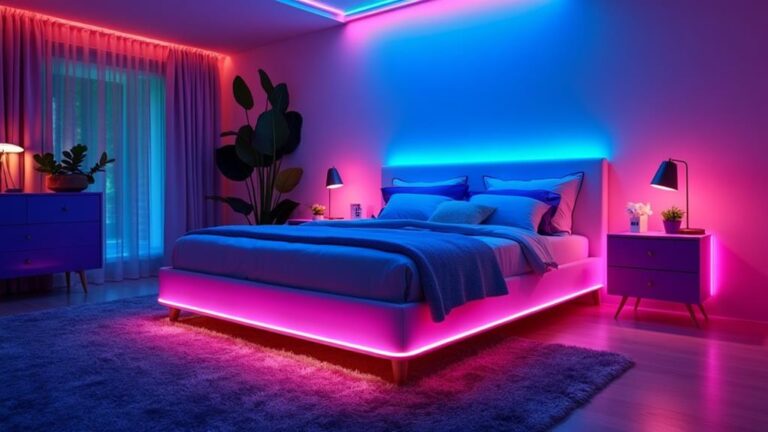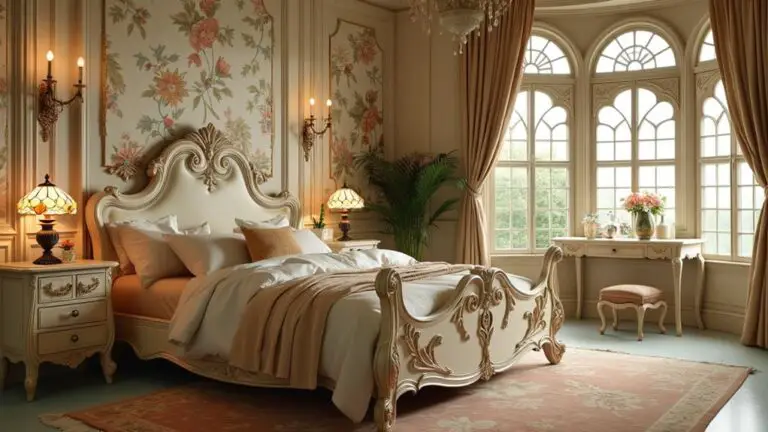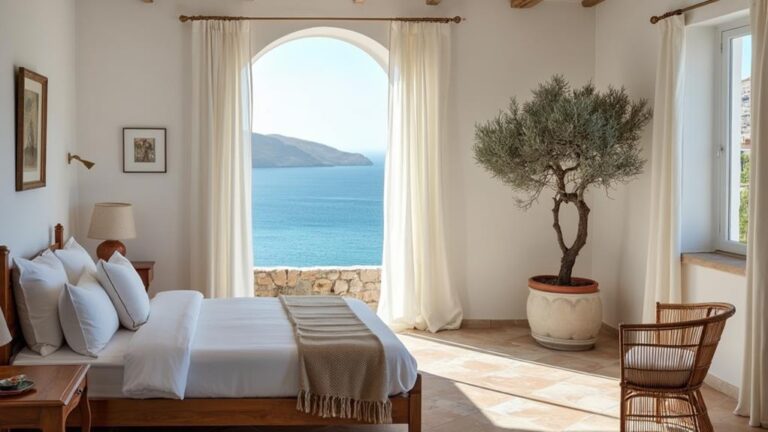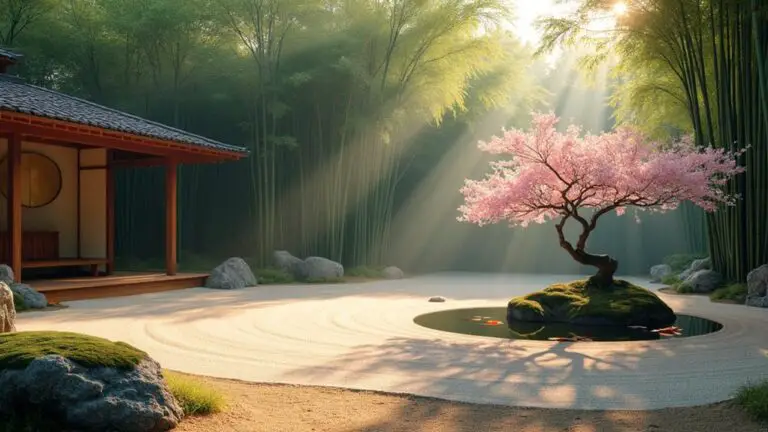Chinoiserie Chic: Asian-Inspired Elegant Room Designs
I'm passionate about Chinoiserie chic, an elegant design style blending Eastern and Western aesthetics. It's all about creating exotic, vibrant spaces with intricate Asian motifs like pagodas, dragons, and floral patterns. Blue and white Chinese porcelain is a timeless staple, while vibrant colors and layered textures add depth. I love how it mixes ornate elements with contemporary pieces, striking a perfect balance. Thoughtful placement of accent pieces and wallpapers creates stunning focal points. Whether you're aiming for a bold statement or a serene atmosphere, Chinoiserie offers endless possibilities for transforming your space into an enchanting sanctuary.
What To Know
- Blend Eastern and Western aesthetics with vibrant colors, intricate details, and Asian motifs like pagodas and dragons.
- Incorporate blue and white Chinese porcelain as a timeless staple in Chinoiserie-inspired room designs.
- Use layered textures, such as silk and linen, alongside lacquered wood furniture to create depth and sophistication.
- Balance ornate Chinoiserie elements with sleek contemporary pieces for a modern interpretation of the style.
- Create focal points with bold Chinoiserie wallpapers or strategically placed porcelain pieces to enhance visual interest.
The Essence of Chinoiserie Chic
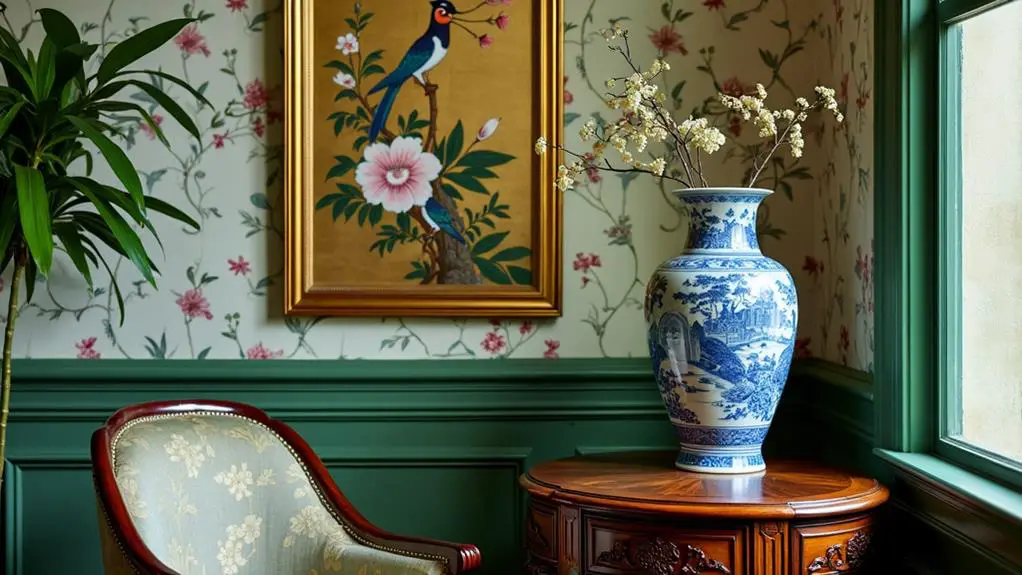
Many interior design enthusiasts are drawn to Chinoiserie chic, a style that beautifully marries Eastern and Western aesthetics. I've always been captivated by its unique blend of Asian motifs and European techniques, which emerged during the French Rococo period. The essence of Chinoiserie lies in its ability to evoke exotic elegance through vibrant colors, intricate details, and luxurious materials.
When I incorporate Chinoiserie into a space, I often use elements like pagodas, dragons, and floral patterns to create visual interest. The iconic blue and white Chinese porcelain is a staple, adding a touch of timeless sophistication.
What I love most about Chinoiserie is its whimsical interpretation of Asian culture, which allows for creative expression in modern interiors. By balancing ornate motifs with contemporary furnishings, I can achieve a harmonious and stylish design that feels both fresh and timeless.
Key Design Elements
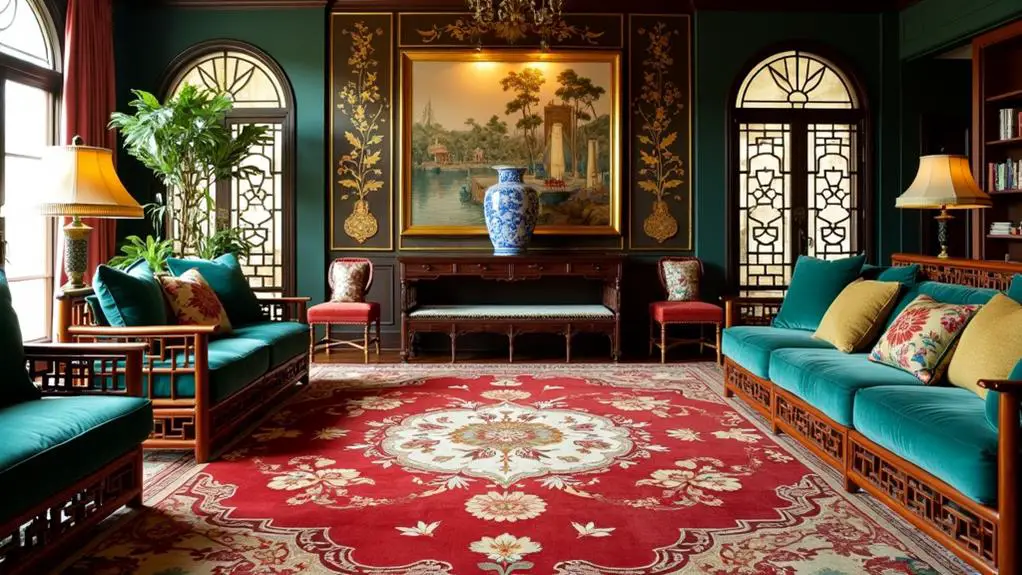
To truly capture the essence of Chinoiserie chic in your home, you'll need to focus on key design elements that define this unique style.
I've found that incorporating vibrant colors, especially the classic blue and white Chinese porcelain patterns, instantly elevates any space.
I love using intricate furniture pieces with lacquered wood finishes and Ming-style ceramics to add sophistication.
Layering textiles and patterns, like floral wallpapers and decorative accessories, creates a rich, textured environment that's both visually striking and inviting.
I always include iconic Chinoiserie motifs such as pagodas, dragons, and foo dogs to root the design in traditional Chinese aesthetics.
Don't forget to embrace asymmetry and organic forms – they offer a playful yet elegant contrast to more structured modern elements, perfectly embodying the Chinoiserie style.
Color Palettes and Textures
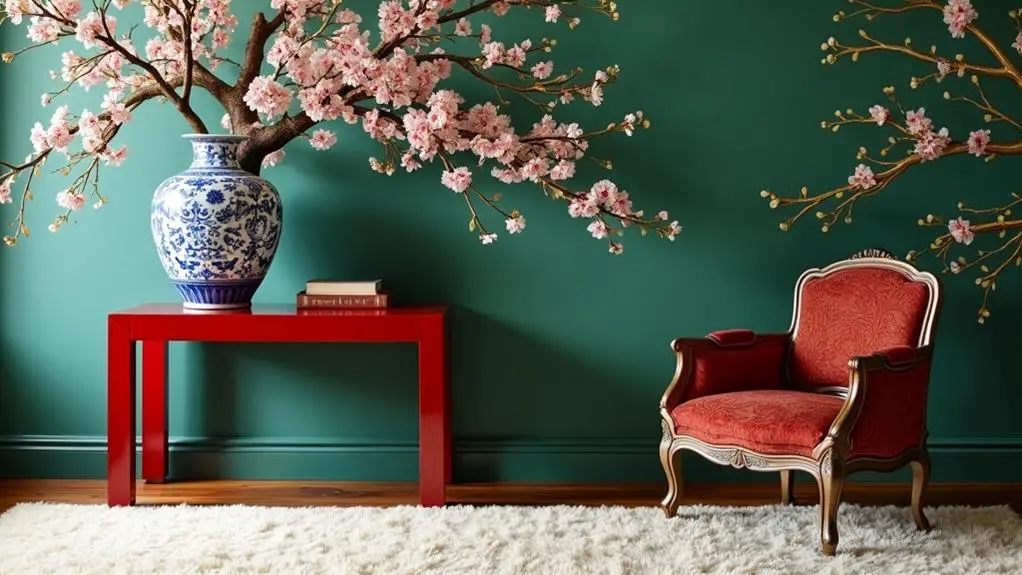
How can you create a truly enchanting Chinoiserie-inspired space? I've found that color palettes and textures are key to achieving this look. Vibrant hues like bold reds, rich blues, and lush greens reflect traditional Chinese art, while lacquered finishes and gilding add opulence to furniture and decor.
To elevate your Chinoiserie chic design, consider:
- Incorporating blue and white porcelain pieces for a classic yet modern touch
- Layering various textures like silk, cotton, and linen for a dynamic atmosphere
- Using floral and nature-inspired wallpapers as a whimsical backdrop
I love how these elements work together to create a cohesive and elegant look. The combination of bold colors, intricate patterns, and luxurious textures truly brings the essence of Chinoiserie to life in any room.
Furniture and Accent Pieces

Building on the foundation of vibrant colors and luxurious textures, we can now explore the furniture and accent pieces that truly define Chinoiserie chic.
I'm particularly drawn to lacquered wood pieces, often embellished with gold leaf and intricate detailing. These items reflect traditional craftsmanship and elegance, forming the cornerstone of Chinoiserie furniture.
For accent pieces, I love incorporating blue-and-white porcelain ginger jars and Ming-style ceramics. They're not just decorative; they're functional too.
I'll often create visually striking focal points by clustering ginger jars and vases on mantels or consoles.
When it comes to seating, I'm fond of Thomas Chippendale's Ribbon Back dining armchair. It perfectly exemplifies the detailed craftsmanship characteristic of Chinoiserie furniture.
Incorporating Chinoiserie in Modern Spaces
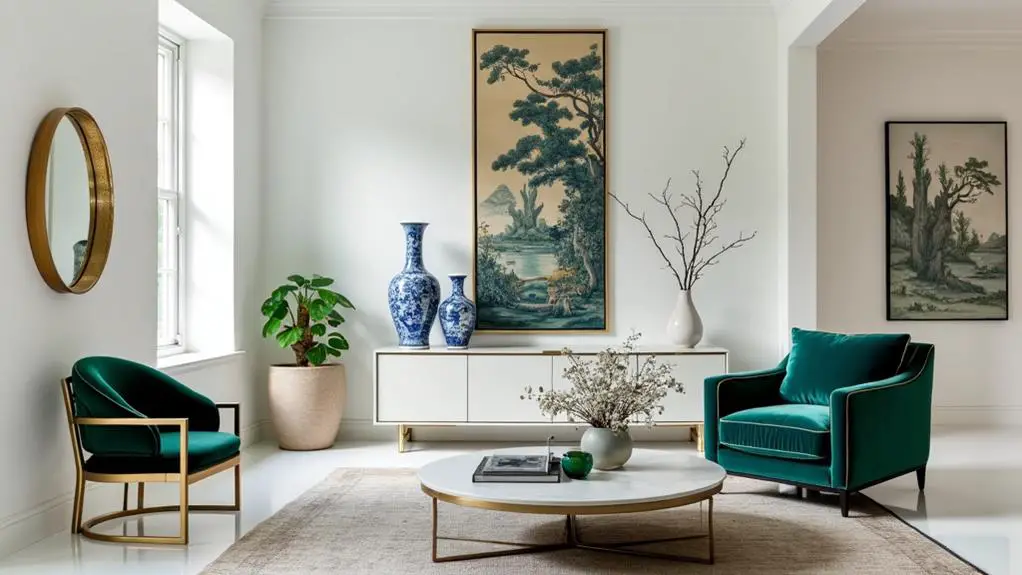
I've found that incorporating Chinoiserie in modern spaces is all about striking the perfect balance between old and new.
Strategic placement of ornate Chinoiserie elements alongside sleek, contemporary pieces can create a mesmerizing visual contrast.
When it comes to color, I prefer to use traditional blue and white palettes as a starting point, but I'm not afraid to experiment with bolder hues to give the space a fresh, modern twist.
Blending Old and New
Blending old and new in interior design can create an enchanting aesthetic, and incorporating Chinoiserie into modern spaces is a perfect example of this fusion.
I've found that Chinoiserie chic can be seamlessly integrated into contemporary interiors by:
- Using bold wallpapers as focal points
- Pairing traditional blue and white pottery with geometric furniture
- Incorporating hand-painted murals in entertaining areas
These elements add warmth and visual interest to minimalist designs, creating a sophisticated balance between Eastern and Western aesthetics.
I love how subtle Chinoiserie motifs in decorative accents or artwork can transform a space without overwhelming it.
The vibrant colors and delicate patterns of Chinoiserie chic enhance modern interiors, providing an energetic yet balanced atmosphere.
Strategic Placement Techniques
Strategic placement is key when incorporating Chinoiserie elements into modern spaces. I've found that thoughtfully positioning blue and white porcelain pieces can create stunning focal points while maintaining a cohesive design aesthetic. I love using Chinoiserie wallpaper on an accent wall to enhance both traditional and contemporary furnishings. When I want to add a touch of exotic elegance without overwhelming the space, I'll use Chinoiserie motifs sparingly in decorative pillows or art.
| Chinoiserie Element | Placement Strategy |
|---|---|
| Porcelain pieces | As focal points |
| Wallpaper | Accent wall |
| Decorative pillows | Sparse distribution |
| Lacquered tables | With modern furniture |
To balance the whimsical with the contemporary, I pair clean-lined modern furniture with Chinoiserie elements like lacquered tables or intricately designed accessories. Integrating natural elements alongside Chinoiserie decor fosters a harmonious indoor-outdoor living feel, enhancing the overall warmth of the space.
Color Palette Considerations
When incorporating Chinoiserie elements into modern spaces, one must carefully consider the color palette to strike the right balance between tradition and contemporary design.
I've found that vibrant hues like reds, blues, and golds can create a stunning backdrop for Chinoiserie-inspired home decor. To achieve a harmonious look, I often layer colors through textiles and wallpapers, adding depth and visual interest.
Here are three key strategies I use when working with Chinoiserie color palettes:
- Incorporate blue and white porcelain as accent pieces
- Balance bold patterns with earthy tones like greens and corals
- Use bright colors and intricate patterns sparingly to evoke luxury without overwhelming the space
Mixing Eastern and Western Aesthetics
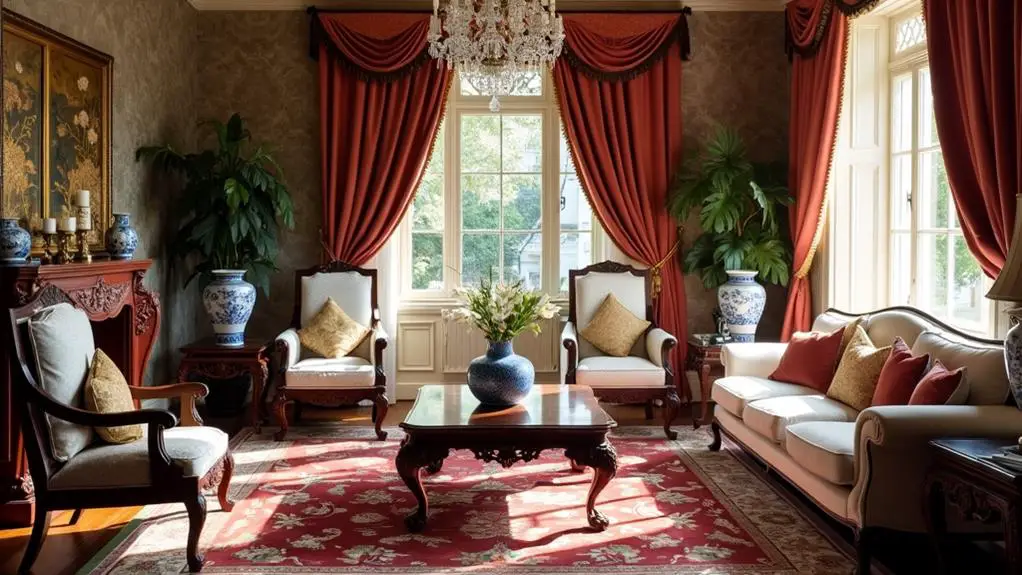
Chinoiserie chic offers an enchanting approach to mixing Eastern and Western aesthetics in interior design.
I've found that incorporating whimsical Asian motifs like pagodas and dragons into a living room can create a harmonious blend of cultures.
It's crucial to balance vibrant colors and intricate patterns with clean-lined, modern furnishings.
I love using blue and white porcelain pieces as accents to enhance the fusion of styles.
Nature-inspired themes, particularly floral and bird motifs, work wonderfully when layered with minimalistic elements.
To achieve an effective mix, I carefully consider proportions and placement, ensuring Chinoiserie elements complement rather than overwhelm the overall decor.
Creating a Serene Chinoiserie Atmosphere
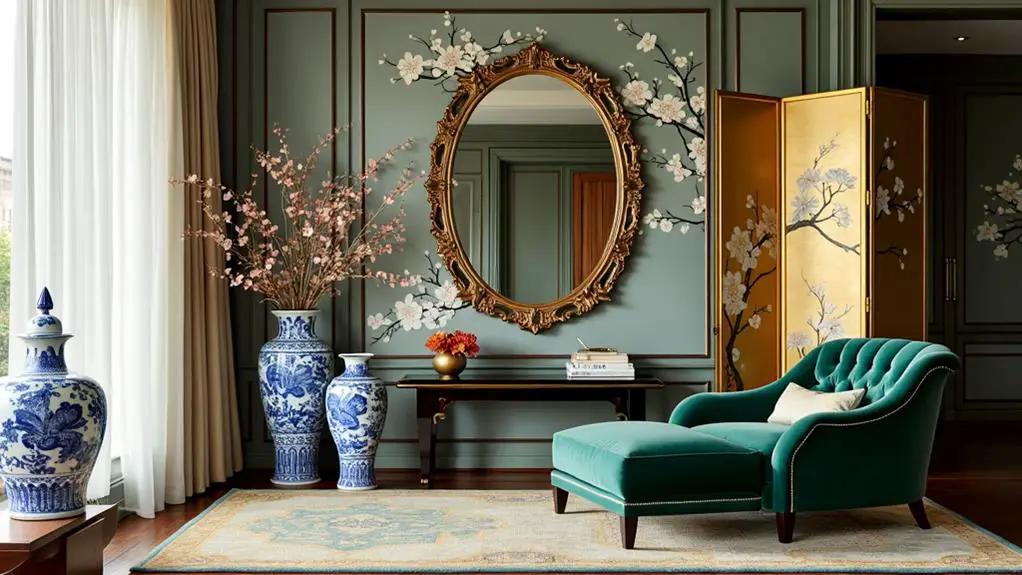
I've found that creating a serene Chinoiserie atmosphere requires a delicate balance of Eastern and Western elements.
By incorporating soothing color palettes of soft blues, greens, and whites, I can instantly evoke a sense of tranquility associated with traditional Asian decor.
These calming hues serve as the perfect backdrop for mixing Chinoiserie patterns and motifs with more contemporary Western furnishings, resulting in a harmonious and peaceful space.
Balanced Eastern-Western Elements
Creating a serene Chinoiserie atmosphere requires a delicate balance of Eastern and Western elements.
In my experience, the key to achieving this style in a room lies in blending asymmetrical designs with organic forms. I've found that incorporating vibrant hues like reds and blues alongside softer tones creates a harmonious ambiance.
To enhance the East-West fusion, I recommend integrating:
- Blue and white porcelain accents
- Lacquered finishes on furniture pieces
- Intricate floral patterns in textiles or wallpaper
I've discovered that layering textures and patterns is essential.
For instance, pairing classic chinoiserie wallpaper with modern furniture creates visual interest without overwhelming the space.
Additionally, I always include natural elements like bamboo or floral arrangements to evoke a sense of calm and connection to the outdoors, further enriching the serene atmosphere of the room.
Soothing Color Palettes
A palette's power in Chinoiserie design can't be overstated.
I've found that soothing color choices are key to creating a serene atmosphere reminiscent of traditional Chinese gardens. Soft hues like pale blues, greens, and blush tones work wonders in establishing a tranquil environment.
I often incorporate blue and white porcelain, a Chinoiserie staple, to introduce calming colors while maintaining aesthetic cohesion.
Layering shades of a single color, such as pale blue with navy accents, adds depth and tranquility.
I love using natural elements like floral patterns and botanical motifs in textiles and wallpapers to complement these soothing palettes.
Light, airy fabrics such as linen and silk in neutral tones soften the overall look, emphasizing the delicate elegance characteristic of Chinoiserie chic.
These elements combine to create a harmonious, calming space.
Conclusion
I've taken you on a journey through the enchanting world of chinoiserie chic, where East meets West in a dance of elegance. As you've seen, it's not just about decorating; it's about creating a harmonious sanctuary. Whether you go all-in or add subtle touches, chinoiserie can transform your space into a timeless oasis. So don't be afraid to let your inner designer bloom like a delicate cherry blossom – embrace the beauty of chinoiserie and make it your own.


